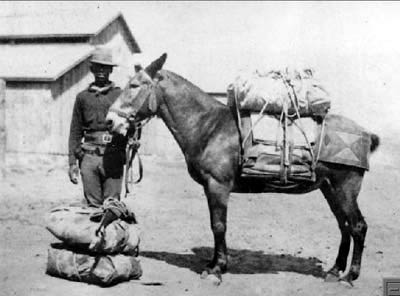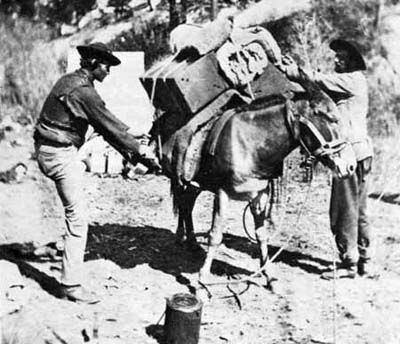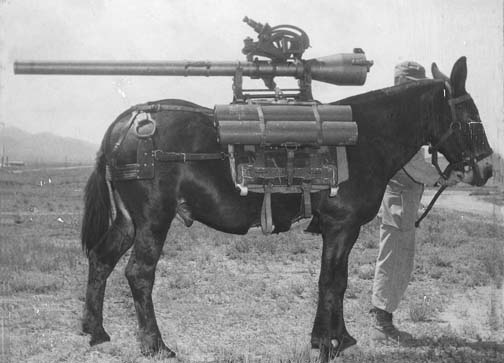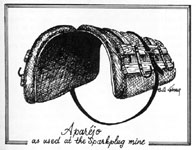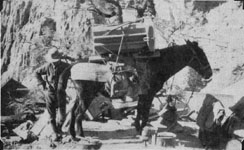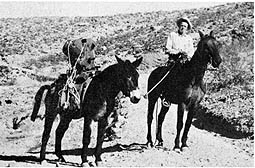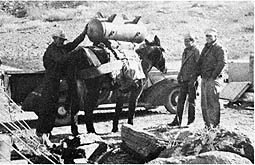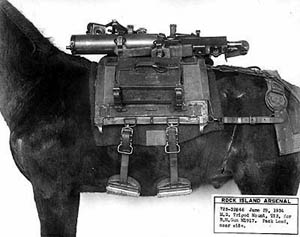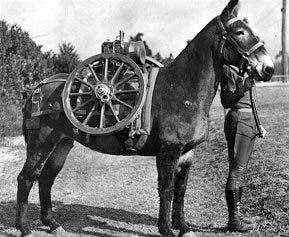One type packsaddle you're not likely to see
any more is the aparejo (pronounced ah-pah-ray'ho). The aparejo
originated in Mexico, and Mexican packers used it extensively
in the 1850s in California packing freight from seaports to inland
mining camps. There was a time in the 1880s when long strings
of mules coming out of the Sierras were common sights; these
trains were often outfitted with aparejo packs carrying wood
to the charcoal kilns of the Cerro Gordo silver mine and to the
northern towns for cooking and heating.
In years past, the aparejo was often used
in the eastern Sierras by commercial pack outfits for extremely
large loads and bulky objects, like lumber. During the 1940s,
it was in use every summer in the Sierra Club High Trips. Two
stoves were used by the club, each weighing over 200 pounds,
and two mules with aparejo packs were used to move the stoves
from camp to camp. In those days the High Trips had groups numbering
as many as 200 guests plus 12 packers and a commissary crew.
The load was considerable, especially because the equipment then
was made of heavy metals and not of the lightweight alloys back-country
equipment is now fashioned from. The packer who hauled the stoves
had one string of five mules; two carried the stoves atop aparejos
and the other three mules had regular sawbuck packs suitable
for carrying kitchen equipment.
The sawbuck sits on top of the mule, but he
aparejo blankets a pack animal's back and evenly distributes
the load. The pad (which is the aparejo) is made of leather and
stuffed with flat grass. It is wetted down before use, and as
it dries, it molds to the back of a mule. Two boards are placed
near the top of the pad, usually 4 x 4s in lengths equal to those
of the pad. A cinch about ten to twelve inches wide is placed
over the wood platform and is attached by latigoes to a similar
cinch running under the mule's belly. An exceptionally wide breeching
fits close under the animal's tail. After the pack is secured,
the load is placed on the boards, and a tarp is thrown over the
load and lashed down with an aparejo hitch.
Not too many outfitters are left who know
how to pack an aparejo. Two men from Owens Valley who packed
them in the eastern Sierra were Fred Moore and Tommy Jefferson.
Every year Tommy would single out two green commissary boys to
help him load the stoves in camp. He would instruct them that
they had to be careful not to drop their end which was the fir
box and made of cast iron. Tommy would take the oven end, alone,
and they would lift together. The boys' end weighed about 158
pounds and Tommy's end weighed only about 60 pounds it'd usually
take about two weeks for those boys to finally catch on.
Along with packing the stoves each summer,
Tommy and Fred packed other individually heavy items. The first
time I met both of them was in September 1953. We all rode up
the Mt. Whitney trail from Whitney Portal on the eastern slope
of the Sierras. We rode to about the 13,000foot level of
the pass to pick up parts of an air compressor left by the trail
crew. The drive shaft went on one mule, a huge air cylinder on
another, and various other parts we loaded on the remaining three
mules. The heaviest load was about 450 pounds.
One mule lay down on the trail and refused
to get up; the load was unpacked, and after he was on his feet,
the load was repacked. We continued to the pack station where
the critter pulled the same routine again.
Equipment wasn't the only load Tommy and Fred
and their mules packed. Before helicopters were able to fly at
high elevations, injured or ill persons were put into wire stretchers
and placed on top of an aparejo for a ride to the nearest first
aid. Rescues of this kind were made at least once a summer.
In 1972, after eight years of owning and operating
Mt. Whitney Pack Trains, Tommy sold the outfit and the aparejo
packs. To my knowledge, they aren't used any more; a part of
the old west has died.
By Mary Jefferson.
October 1978
The Western Horseman










![]()
